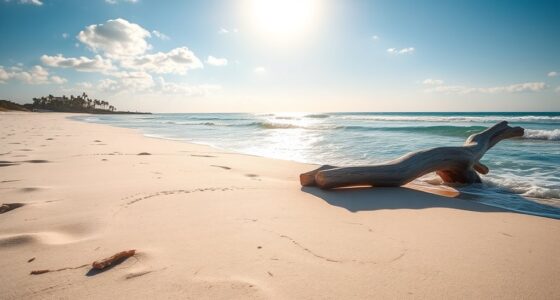Beach erosion happens when natural forces like waves, currents, and winds wear away shoreline material, and human activities such as construction and sand mining make it worse. This process harms ecosystems, reduces land for communities, and impacts tourism and fishing. To conserve beaches, natural defenses like dunes and vegetation are essential, along with engineering solutions and community efforts. Continue exploring to learn how everyone can help protect and restore our coastlines.
Key Takeaways
- Natural forces like waves, storms, and tides cause shoreline material to wear away, leading to beach erosion.
- Human activities such as construction and sand mining accelerate erosion, disrupting natural coastal defenses.
- Conservation strategies include building seawalls, restoring dunes, planting native vegetation, and creating oyster reefs.
- Monitoring shoreline changes through technology helps identify erosion hotspots and guides timely conservation efforts.
- Community involvement and education are vital for sustainable beach management and long-term erosion prevention.
What Causes Beach Erosion?

Beach erosion occurs when natural forces remove sand and sediment from the shoreline faster than it can be replenished. Waves constantly crash against the coast, carrying sand away and reshaping the shoreline. Strong storms and hurricanes intensify this process, causing significant sand loss through powerful wave action. Wind also plays a role by blowing loose sand inland or along the coast, gradually wearing down the beach. Tides rise and fall, exposing parts of the shoreline to erosion during low tide. Human activities, such as construction, dredging, or removal of vegetation, can accelerate erosion by disturbing natural sand supply. Additionally, dune systems act as natural barriers against erosion, helping to protect the coastline. These systems are vital for coastal resilience, and their preservation is essential for long-term shoreline stability. Natural processes like sediment transport continuously shape the coast and influence erosion patterns. Together, these natural and human factors disrupt the balance, leading to the gradual shrinking of beaches if not properly managed or mitigated. Regular assessment and intervention, such as the implementation of vertical storage solutions, can help protect and restore eroding shorelines.
The Impact of Natural Forces on Shorelines

You’ll notice that wave action constantly reshapes shoreline features, eroding some areas while building others. Storms and strong winds intensify these effects, often causing rapid and severe changes. Understanding how these natural forces work helps you better grasp their role in beach erosion and conservation efforts. Recognizing the importance of dynamic communication exercises can also foster community and collaborative approaches to shoreline preservation. Additionally, insights into family dynamics and cultural heritage can inform more sustainable and culturally sensitive conservation strategies. Implementing low carb dietary principles, such as focused meal planning, can improve community health outcomes in coastal regions by promoting healthier lifestyles that support environmental stewardship. Awareness of headphone types and their proper use can enhance educational programs aimed at engaging local communities in conservation activities. Furthermore, understanding the natural forces involved in shoreline change highlights the importance of monitoring and adaptive management practices to mitigate erosion impacts effectively.
Wave Action Effects
Wave action is one of the most powerful natural forces shaping coastlines. It constantly impacts the shoreline, eroding and redistributing sand and sediments. As waves crash against the coast, they remove material from beaches, gradually wearing down cliffs and reshaping the landscape. The effects depend on wave size, frequency, and energy. You should note that:
- Larger, powerful waves cause more erosion.
- Repeated wave action prevents new sediment buildup.
- Long-term wave patterns influence shoreline stability.
- Seed allergies may impact coastal communities where dietary restrictions are common, highlighting the importance of awareness in environmental health.
- Regular monitoring of coastal erosion patterns helps in implementing effective conservation measures.
- The rate of erosion is also affected by wave energy, which varies with storm activity and ocean currents, making it a crucial factor in shoreline changes.
- Implementing erosion control techniques can significantly reduce the impact of wave action on vulnerable coastlines.
- Additionally, climate change can increase storm intensity and frequency, further accelerating shoreline degradation.
Understanding these effects helps you recognize how natural forces shape your local beaches over time. Wave energy directly impacts erosion rates, and without proper management, coastlines can become increasingly vulnerable. Recognizing the significance of wave action allows for better conservation strategies and more effective shoreline protection.
Storm and Wind Dynamics
Storms and wind are powerful natural forces that considerably influence shoreline changes. When a storm approaches, strong winds generate high-energy waves that can erode beaches rapidly, removing sand and reshaping the coast. Wind-driven currents also transport sediments along the shoreline, sometimes causing significant shifts in beach profiles. During storms, the force of wind and water can break down dunes and other natural barriers, exposing the coast to further erosion. These processes can occur suddenly, leading to noticeable coastline retreat, or gradually over time with repeated storm events. You should understand that storm and wind dynamics are unpredictable but vital factors in shoreline stability. Managing these forces involves designing protective structures and preserving natural buffers like dunes and vegetative cover to mitigate their destructive impact. Additionally, understanding storm and wind dynamics is essential for developing effective conservation strategies that can help reduce shoreline erosion. Recognizing the role of natural buffers, such as dunes and vegetation, can significantly enhance shoreline resilience against storm impacts. Moreover, implementing coastal management practices can help mitigate erosion and protect coastal communities effectively. Understanding the impact of natural forces through research can also improve predictive models and preparedness efforts to safeguard shorelines. Furthermore, the preservation of vegetative cover can serve as a natural defense against wind erosion and storm surge impacts.
Human Activities Contributing to Erosion

Human activities considerably accelerate beach erosion by disrupting natural processes and removing essential vegetation. When you build structures like seawalls or piers, you alter water flow and sediment movement, often leading to increased erosion elsewhere. Coastal development, such as tourism facilities and housing, tends to strip away dunes and plants that naturally protect the shoreline. Additionally, activities like sand mining and trampling vegetation weaken the natural barriers that hold sand in place. These actions reduce the shoreline’s resilience against wave action and storms, making erosion worse. To minimize impact, you should avoid unnecessary construction near beaches, support conservation efforts, and promote sustainable tourism practices. Preserving natural vegetation and dunes is vital for maintaining the shoreline’s stability and preventing further erosion. Implementing diverse plantings and sustainable materials can also help reinforce the shoreline against erosion forces. Moreover, understanding the importance of natural processes such as sediment transport and dune formation is crucial for effective conservation strategies.
The Effects of Beach Erosion on Ecosystems

When beaches erode, habitats for many plants and animals are lost or displaced. This disruption affects marine life that depends on these areas for shelter and breeding. Understanding these impacts helps highlight the importance of conservation efforts. Additionally, recognizing the cultural and social significance of beaches can motivate community-driven artistic and educational initiatives to promote awareness and sustainable practices.
Habitat Loss and Displacement
As beach erosion accelerates, ecosystems that rely on stable coastal habitats face significant disruption. You might notice plant and animal species losing their homes, forcing them to relocate or perish. This habitat displacement affects biodiversity and the balance of local ecosystems. Without their natural habitats, species struggle to find shelter, food, and breeding grounds. The consequences include:
- Loss of nesting sites for birds and turtles
- Reduced shelter for coastal invertebrates
- Disruption of plant communities essential for dune stability
This habitat loss can lead to long-term ecological shifts, making recovery difficult. As the shoreline changes, the delicate relationships among species break down, threatening the health of entire ecosystems. Protecting these habitats is vitalto prevent further displacement and preserve coastal biodiversity.
Impact on Marine Life
How does beach erosion directly impact marine life? As the shoreline recedes, habitats like tide pools, seagrass beds, and coral reefs become exposed to harsher conditions or destroyed. Marine animals such as crabs, mollusks, and fish rely on stable coastal zones for breeding, feeding, and shelter. When erosion occurs, these species lose critical nesting sites and food sources, forcing them to relocate or face decline. Additionally, increased sediment runoff from eroded beaches clouds water, smothering coral reefs and reducing sunlight needed for photosynthesis. This disrupts the entire food chain and decreases biodiversity. You might notice fewer fish or shellfish in affected areas, signaling ecosystem imbalance. Overall, beach erosion threatens marine life’s survival by destabilizing their habitats and altering environmental conditions essential for their well-being. Effective communication with legal counsel is crucial for addressing the economic impacts and developing strategies for habitat conservation.
Economic Consequences for Coastal Communities

Coastal erosion directly impacts the economies of nearby communities by reducing land available for tourism, housing, and businesses. When beaches shrink, tourism declines because visitors seek wider, safer shores, leading to fewer dollars spent locally. Property values drop as homes and commercial buildings face increased risk or become uninhabitable. You may also see a decline in fishing and maritime activities, which are essential to many coastal economies. The economic consequences include:
Coastal erosion harms local economies by reducing tourism, property values, and maritime activities.
- Loss of revenue from tourism and local businesses
- Increased costs for shoreline protection and repairs
- Decline in property values and tax income
These effects pressure community budgets and can lead to job losses, making it harder to recover from erosion’s financial toll. Addressing erosion isn’t just about the environment; it’s about protecting your community’s economic future.
Monitoring and Assessing Erosion Patterns

Monitoring and evaluating erosion patterns is essential for understanding how coastlines change over time and for developing effective conservation strategies. You can use tools like aerial photography, satellite imagery, and GPS mapping to track shoreline movement accurately. Regular surveys help identify erosion hotspots and measure the rate of coastline change. Tide gauges and sediment analysis provide insights into how natural forces and human activities influence erosion. By analyzing this data, you can spot trends, predict future erosion, and determine which areas need immediate attention. Keeping detailed records allows you to assess the effectiveness of any conservation efforts. This ongoing assessment ensures you stay informed about evolving erosion patterns, enabling timely interventions to protect the shoreline and maintain coastal stability.
Strategies for Natural Shoreline Protection

Implementing natural shoreline protection strategies offers an effective way to reduce erosion while maintaining the coastline’s ecological integrity. These methods harness natural processes to stabilize beaches and support local ecosystems. For example, planting native vegetation helps bind soil and absorb wave energy, reducing runoff and erosion. Creating or restoring dunes acts as a buffer, dissipating wave force before it reaches inland areas. Additionally, installing oyster reefs or submerged breakwaters can slow water flow and trap sediments naturally.
Natural shoreline protection reduces erosion by restoring dunes, planting native vegetation, and installing oyster reefs to support ecosystems.
- Protect existing habitats to preserve their erosion control functions
- Use soft engineering techniques that blend with the environment
- Promote community involvement to ensure sustainable practices
Engineering Solutions and Structural Interventions

Building on natural shoreline protection methods, engineering solutions and structural interventions offer targeted ways to combat erosion. You can install seawalls, which act as barriers to deflect wave energy away from the shore, reducing erosion. Groynes, perpendicular structures built along the coast, trap sand and help maintain beach width. Revetments, sloped structures made of concrete or rock, absorb wave impact and protect vulnerable areas. Additionally, beach nourishment involves adding sand to replace lost material, restoring the shoreline’s natural profile. While effective, these methods require ongoing maintenance and can sometimes disrupt natural processes if not carefully planned. You should work with engineers to assess your coastline’s specific needs, ensuring that interventions complement natural defenses and minimize environmental impact.
Community Involvement in Conservation Efforts

Your participation in conservation efforts can make a real difference, as volunteers help protect and restore beaches. By supporting local education initiatives, you raise awareness and encourage responsible behavior in the community. Community-led projects empower residents to take ownership and implement lasting solutions for erosion control.
Volunteer Participation Benefits
Volunteer participation plays a crucial role in conserving beaches by fostering a sense of community ownership and responsibility. When you get involved, you help protect these coastal areas for future generations. Your efforts can lead to tangible benefits, such as increased awareness, stronger community bonds, and more effective conservation actions. By volunteering, you contribute directly to activities like beach cleanups, erosion monitoring, and habitat restoration. These actions not only improve the environment but also empower you and others to take action. Your involvement encourages others to join, creating a ripple effect of positive change. Remember, your participation makes a real difference in maintaining healthy, resilient beaches for everyone to enjoy.
- Promotes community collaboration
- Boosts environmental awareness
- Enhances local conservation efforts
Local Education Initiatives
Local education initiatives play a crucial role in involving communities directly in conservation efforts. When you participate in nearby workshops, school programs, or informational campaigns, you gain a clearer understanding of beach erosion causes and prevention strategies. These initiatives often provide practical tips on reducing your environmental impact, like avoiding trampling dunes or improper waste disposal. By engaging locally, you help spread awareness and motivate others to take action. Schools and community groups become hubs for conservation, fostering a sense of shared responsibility. Your involvement through educational programs strengthens community ties and encourages sustainable habits. Ultimately, well-informed locals are more likely to support policies and practices that protect beaches, ensuring these essential ecosystems endure for future generations.
Community-Led Projects
Community-led projects empower residents to take direct action in conserving their beaches and preventing erosion. When you get involved, you help develop tailored solutions that fit your local environment. These projects often include activities like shoreline planting, debris removal, and installing natural barriers. By participating, you contribute to a stronger, more resilient coastline.
Remember, your efforts can:
- Enhance natural defenses against erosion
- Foster community pride and awareness
- Encourage sustainable practices for future generations
Engaging in these initiatives gives you a sense of ownership and responsibility. Collaboration with neighbors and local authorities creates a united front, making conservation efforts more effective. Your involvement not only protects the beach but also preserves it for everyone’s enjoyment.
Promoting Sustainable Tourism and Beach Management

Promoting sustainable tourism and effective beach management is essential to protect coastlines from further erosion while ensuring that visitors can enjoy these natural treasures responsibly. You can help by respecting designated areas, avoiding damage to dunes and vegetation, and following local guidelines. Implementing visitor limits during peak seasons reduces pressure on fragile environments. Supporting eco-friendly accommodations and transportation minimizes your ecological footprint. Educate yourself about the importance of conservation efforts and participate in beach clean-ups when possible. Responsible tourism balances economic benefits with environmental protection, ensuring beaches remain vibrant and resilient. By being mindful of your actions and advocating for sustainable practices, you contribute to long-term preservation. Together, these efforts help maintain healthy beaches for future generations to enjoy and appreciate.
Frequently Asked Questions
How Does Climate Change Influence Beach Erosion Rates?
Climate change substantially impacts beach erosion rates. You might notice rising sea levels, which cause higher water levels and more frequent flooding, wearing away the shoreline. Increased storm intensity and frequency also lead to stronger wave action that accelerates erosion. Additionally, warmer temperatures can weaken natural coastal barriers like dunes and coral reefs. Overall, climate change worsens erosion, threatening your local beaches and the ecosystems they support.
What Role Do Invasive Species Play in Shoreline Stability?
Did you know that invasive species can alter shoreline stability by up to 30%? They often outcompete native plants that naturally hold sand and soil in place. When these native plants decline, the shoreline becomes more vulnerable to erosion. By disrupting local ecosystems, invasive species weaken natural barriers, making coastlines more prone to damage from storms and waves. Managing these species is essential for maintaining healthy, resilient shorelines.
Can Artificial Reefs Effectively Prevent Beach Erosion Long-Term?
Artificial reefs can help prevent beach erosion over the long term by dissipating wave energy before it reaches the shoreline, reducing erosion. When properly designed and maintained, they create a buffer that stabilizes the coast and promotes sediment deposition. However, their effectiveness depends on location, reef size, and environmental factors. You should consider integrating reefs with other conservation methods for an all-encompassing approach to shoreline protection.
How Do Local Policies Impact Conservation Success?
Think of local policies as the steering wheel of a ship—your conservation efforts depend on how well they’re directed. When policies support sustainable practices, restrict harmful activities, and fund protection projects, you see better success in preserving beaches. Conversely, weak or conflicting policies can cause your efforts to falter like a boat without a rudder. Strong, clear policies empower you to make lasting impacts on beach conservation and erosion prevention.
What Innovative Technologies Are Emerging for Shoreline Protection?
You’re curious about emerging technologies for shoreline protection. Innovative methods include biodegradable geotextiles that stabilize sand, advanced wave energy dissipation systems, and smart sensors that monitor erosion in real-time. These tools help you respond quickly and effectively, reducing erosion risks. By adopting such cutting-edge solutions, you can enhance shoreline resilience and protect coastal ecosystems for future generations.
Conclusion
Understanding beach erosion is like tending a fragile garden—you must actively care for it before the damage spreads. By recognizing natural forces, human impacts, and conservation strategies, you become part of the solution. Your involvement can turn the tide and protect these essential ecosystems. Remember, just as a single drop can cause ripples, your efforts contribute to a stronger, more resilient shoreline—preserving nature’s delicate balance for generations to come.










